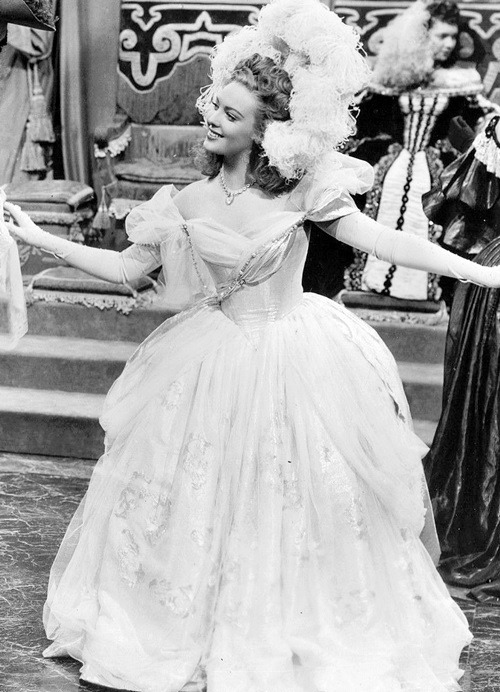Forever Amber (1947)

Imitation is the sincerest form of flattery, and in the decade or so after the release of Gone With the Wind, we saw a slew of epic-scale Hollywood attempts to cash in, and, hopefully recreate the magic, of that immortal classic. Forever Amber was 20th Century Fox’s GWTW with a dose of Jezebel (itself an attempt to capitalize on GWTW in 1938). Unfortunately, everything about Forever Amber is a dilution in quality, from the casting to the sets and source material. If lovely costumes, and the lovelier Linda Darnell, pique your interest by all means seek this out.
Amber St. Clair (Darnell) is a woman in the 1600s who refuses to settle for second best. She ends up going to London with a cavalier named Bruce Carlton (Cornel Wilde) whom she quickly falls in love with. Unfortunately, Bruce is drawn deeper into the war against Oliver Cromwell, and Amber rises up the social ladder, seeking a husband to place her in the lap of luxury.

Where Jezebel and Gone With the Wind had strong source material with deeply rooted historical significance, Forever Amber’s history is distant for American audiences, or really anyone without a penetrating admiration for British history. Oliver Cromwell’s overthrow and the rise of Charles II was a bloody time in English history leading into the Restoration of the monarchy. Unfortunately, since this is an American production, there’s no context for these events other than a text crawl in the opening sequence. With the history swirling around the characters, but without affecting them, the history takes a backseat to Amber’s social climbing and romance with Bruce (I had no idea Bruce was such a popular name for Englishmen). Essentially, director Otto Preminger turns Forever Amber into a stageplay with American actors walking around British sets. The majority of the stars, George Sanders being the noticeable exclusion, don’t concern themselves with speaking the Queen’s English, leaving a Britain populated with dyed in the wool Americans. I’d have found it easier to believe the events took place in one of New York’s boroughs!
The lack of any kinship to Britain also dulls the stakes. Cromwell and the Restoration saw a lot of people lose their heads, yet Amber’s life, or the life of her lover, are never in true peril. I can’t comment as to the role of history within events, having never read the source material, but the movie plays like Vanity Fair than anything resembling GWTW or Jezebel. Around the second hour, when Bruce gets sick, you’re assuming it’s the plague, and yet there isn’t an explanation for what it is. Does it have to do with the war? It plays like a reminder, and extension of, the yellow fever outbreak in Jezebel. Only here, we watch Amber care for Bruce, save his life from a maid trying to strangle him under the guise of putting him out of his misery, and realize for the umpteenth time she loves him.

These reminders of things we already know happen way too often (the love story specifically), emptying the romance of any significance. Scarlett O’Hara realizes her love for Rhett Butler in one sweeping epiphany, not every half an hour, making Scarlett’s loss of Rhett acute because her realization happens once he’s gone. Amber falls in love with Bruce, only to move on into a new relationship with little thought, or when the script dictates a split. When Bruce returns, it’s right back to the love, but the audience isn’t on Amber’s side. Instead, we’re meant to see Amber as a Delilah or, the already named Jezebel. She’s in love with Bruce, yet falls for men of position because she refuses to be ordinary. Even when she’s willing to give up the various men in her life and live a life of domesticity with Bruce and their son, her sins continue to crop up, culminating in her giving her son away in the tired trope of “him being better of without me.” These issues are all necessary for the time period, and Fox tried to refrain from making too many significant changes to please the Hays Office, but there’s never any weight to events, and the aforementioned lack of consequences and suspense leaves us with a Scarlett O’Hara and no true redemption for her.
Linda Darnell is gorgeous, and works well in a role slightly higher than a clotheshorse (seriously, her costumes are as elaborate as her hairstyles). In the accent department, she isn’t the worst offender; Cornel Wilde continues to unimpress, especially with his monotone American cadence. When she gives up her son, there is intense emotion, but too much of the runtime finds Darnell playing the coquette, batting her eyes and playing up her bosoms to get what she wants. Wilde, and all the other male characters, are little more than pawns to be moved, or disciplinarians trying to control her. George Sanders plays the minor role of Charles II. The only Englishman in the bunch, Sanders is far too good for an insignificant role.

Despite a lush setting and breathtaking costumes, Forever Amber is a lifeless affair. Darnell holds the film, but is smothered by the excessive pageantry she’s forced to display, and confined to a character you’re never rooting for. This is Gone With the Wind if, by the end, you couldn’t root for Scarlett in any way other than the required way you’re supposed to. If anything, Forever Amber is worth a watch to watch the Restoration through an American lens.
Ronnie Rating:

Interested in purchasing today’s film? If you use the handy link below a small portion is donated to this site! Thanks!
Categories
Kristen Lopez View All
Film Editor at TheWrap. Author of the book "But Have You Read the Book: 52 Literary Gems That Inspired Our Favorite Films," put out by TCM and Running Press. Book 2, focused on disability in film, comes out via Applause Books in 2025.
5 thoughts on “Forever Amber (1947)” Leave a comment ›